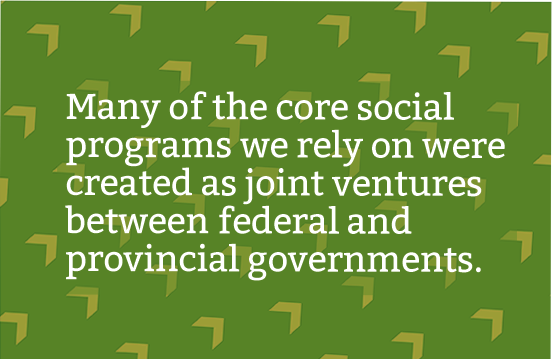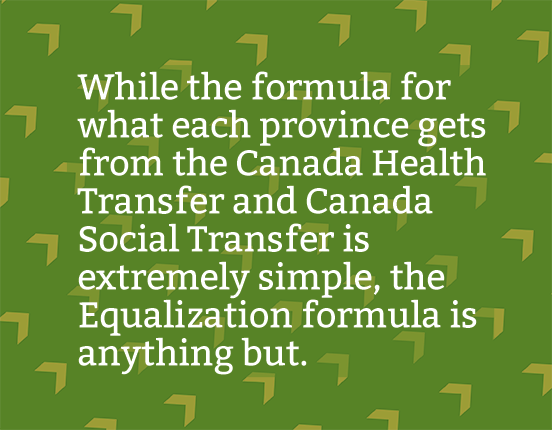March 10, 2015
This year the federal government will send $62.5 billion in transfer payments to provincial and local governments — over one quarter of the federal budget.
Here is an explainer to help you understand why these payments exist, how they work, and why they matter.
What exactly is a transfer payment?
A transfer payment is simply a wire transfer from the Government of Canada’s bank account to a provincial government’s bank account. Every year, the federal government transfers a large portion of its budget (over one quarter this year) to other governments in Canada. Most of this goes to provincial governments.
Why does the federal government give money to provinces and territories?
There are three main reasons why the federal government transfers money to provincial and local governments.
1. To make sure that no matter where someone lives in Canada, their governments have enough money to deliver reasonably comparable public services.
For almost 60 years, the federal government has provided cash support to provincial governments with a below-average access ability to raise revenue, after adjusting for population size and differences in tax rates. This measurement is called “fiscal capacity.” There are two main programs for this purpose: the Equalization program for provinces, and a special payment called Territorial Formula Financing for the three territories. Together these account for about $20 billion, or roughly one-third of the transfer payments made by the federal government.
2. To cover the federal share of programs that federal and provincial governments created together.

Many of the core social programs we rely on were created as joint ventures between federal and provincial governments, a partnership that was very common in the 1960s and 1970s, but less so today. The modern health care and social assistance systems were created this way, along with investments in social housing and post-secondary education. Today, the largest federal contribution towards these programs are rolled up in big multi-purpose pools of cash support that represent the majority of federal transfer payments (the Canada Health Transfer and Canada Social Transfer). Some other programs (e.g., social housing) have their own dedicated funding agreements with specific requirements.
3. To pay for provincial and local governments to do things that the federal government would like to happen.
In the case of some of the smaller federal transfer programs, the federal government provides money to provinces to provide services that are either in provincial jurisdiction or the federal government is not currently set up to manage. This category includes federal funding for provinces to provide skills training programs.
What are the major transfer payments and how do they work?
When people talk about federal transfers or “major” federal transfers, they are typically referring to three programs: the Canada Health Transfer (CHT), the Canada Social Transfer (CST), and Equalization.
1. The Canada Health Transfer is the way that the federal government pays for its share of public health care costs. It is a cash transfer payment to provinces and territories worth $32.1 billion in 2014-15.
- Each province gets a share of this pool that is equal to its share of the Canadian population.
- When Canada first introduced public health care across the country, all costs were split 50/50 between federal and provincial governments. In the late 1970s, the federal government shifted to a set annual cash transfer. The payments today cover just under one quarter of provincial health care costs.
- Since 2004, the total pool of funding for the CHT has grown at a rate of six per cent each year. As of 2017-18, that growth rate will be pegged to the rate of nominal growth in GDP, likely between 4 and 5 per cent annually. Provinces have been unhappy about this. The Parliamentary Budget Officer has projected that in the long-term this decision will leave provinces struggling to balance budgets and the federal government with money to spare.
- While provinces have exclusive jurisdiction over health care in the Canadian constitution, the CHT payments buy the federal government some influence. If the provinces don’t meet some basic standards set out in the federal Canada Health Act, the federal government can withhold the money.
2. The Canada Social Transfer is a payment from the federal government to provinces to cover some costs from social programs that were initially sent up as partnerships between federal and provincial governments. It is a cash transfer payment worth $12.5 billion in 2014-15.
- Each province gets a share of the CST that is equal to its share of the Canadian population.
- The CST is a legacy of a set of programs set up as joint ventures between federal and provincial governments with 50/50 cost sharing. These include social assistance, operating costs for post-secondary education, child welfare and protection, and services in old age homes.
- The total pool of funding grows at a rate of 3 per cent per year (which has been the case since 2004 and will continue until at least 2024). The federal government has more recently stated that it “notionally allocates” the CST to go 10 per cent to programs for children, 31 per cent for post-secondary education, and 59 per cent for other social programs. In reality, these payments are not tied to any specific program, so these allocations don’t make any practical difference.
3. The Equalization program is a federal payment that provides cash support to provincial governments that have below-average “fiscal capacity” to raise tax revenue in a given year. It is a $16.7 billion program in 2014-15.
- While the formula for what each province gets from the Canada Health Transfer and Canada Social Transfer is extremely simple, the Equalization formula is anything but.
- At its most basic, the federal government calculates how much tax revenue a province could raise if it had tax rates at the national average. Those provinces that fall below the average (adjusted for population) receive payments that would bring them up to the average.

- The practical application gets murky, only half of natural resource revenues are factored in, because they are strictly provincial jurisdiction. Other changes by the federal government to control costs change what provinces receive. And because the whole program is based on averages, random events can skew outcomes — for example, Quebec’s decision to close a nuclear plant led to Ontario receiving hundreds of millions less in Equalization payments.
- The program was created to make sure that all provinces have the ability to provide reasonably comparable public services at reasonable similar tax rates. This is a goal that’s built into the constitution, though the program itself is not.
- Equalization is a no-strings-attached payment and there is no requirement that actual levels of taxation are similar to other provinces.
- Since 2009 there has been a limit on how much the total pool of funding can grow each year — set at the rate of nominal GDP growth. Before that change, the program was open-ended, which means the federal government made whatever payments were necessary to bring a province up to average fiscal capacity.
What is the one thing I should know if someone brings this up at a cocktail party?
If someone brings up federal transfer payments at a cocktail party, the correct response is to politely excuse yourself and then calmly but quickly gather your belongings and leave.
Why do I always hear about “have” and “have-not” provinces when people talk about federal transfers?
People often refer to provinces that receive Equalization payments as “have-not” and suggest they are being carried by other parts of the country. This is misleading.
Though Ontario receives Equalization payments, the federal government still collects more revenue from Ontarians than it sends back to the province. The reverse is true for Saskatchewan, where the province does not qualify for Equalization but still sees its residents get more back from the federal government than they send to Ottawa.
If someone brings up federal transfer payments at a cocktail party, the correct response is to politely excuse yourself and then calmly but quickly gather your belongings and leave.
The headline number about how much a province receives from the federal government in a given year has very little to do with how well a province is doing. The majority of transfers are simply distributed based on how many residents a province has — so pointing out that Ontario receives the highest amount in federal transfer payments is equivalent to pointing out the not-earth-shattering realization that Ontario has the largest population of Canadian provinces by a wide margin.
Why does the Mowat Centre seem to care about this so much?
Federal transfer payments are a big part of federal and provincial budgets. The way that they’re managed and distributed matter for the public services that Canadians rely on. This is over $60 billion in Canadians’ tax dollars, so it is important to make sure that they’re handled in a way that is fair and efficient, even if the details are less than thrilling.
The Mowat Centre has a mandate to look at Canadian policy from the Ontario perspective, and federal transfers are filled with examples where these policies have served Ontario poorly. Federal tweaks to Equalization alone have meant billions fewer dollars coming back to Ontario, so it tends to capture our attention.
— Noah Zon






